The fungal type II myosin in Penicillium marneffei, MyoB, is essential for chitin deposition at nascent septation sites but not actin localization
- PMID: 21131434
- PMCID: PMC3067470
- DOI: 10.1128/EC.00201-10
The fungal type II myosin in Penicillium marneffei, MyoB, is essential for chitin deposition at nascent septation sites but not actin localization
Abstract
Cytokinesis is essential for proliferative growth but also plays equally important roles during morphogenesis and development. The human pathogen Penicillium marneffei is capable of dimorphic switching in response to temperature, growing in a multicellular filamentous hyphal form at 25°C and in a unicellular yeast form at 37°C. P. marneffei also undergoes asexual development at 25°C to produce multicellular differentiated conidiophores. Thus, P. marneffei exhibits cell division with and without cytokinesis and division by budding and fission, depending on the cell type. The type II myosin gene, myoB, from P. marneffei plays important roles in the morphogenesis of these cell types. Deletion of myoB leads to chitin deposition defects at sites of cell division without perturbing actin localization. In addition to aberrant hyphal cells, distinct conidiophore cell types are lacking due to malformed septa and nuclear division defects. At 37°C, deletion of myoB prevents uninucleate yeast cell formation, instead producing long filaments resembling hyphae at 25°C. The ΔmyoB cells also often lyse due to defects in cell wall biogenesis. Thus, MyoB is essential for correct morphogenesis of all cell types regardless of division mode (budding or fission) and defines differences between the different types of growth.
Figures


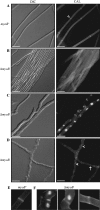
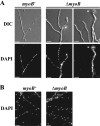
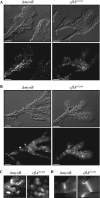

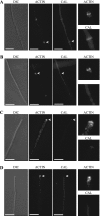
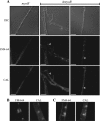

Similar articles
-
Control of morphogenesis and actin localization by the Penicillium marneffei RAC homolog.J Cell Sci. 2003 Apr 1;116(Pt 7):1249-60. doi: 10.1242/jcs.00319. J Cell Sci. 2003. PMID: 12615967
-
Control of morphogenesis in the human fungal pathogen Penicillium marneffei.Int J Med Microbiol. 2002 Oct;292(5-6):331-47. doi: 10.1078/1438-4221-00217. Int J Med Microbiol. 2002. PMID: 12452280 Review.
-
The RFX protein RfxA is an essential regulator of growth and morphogenesis in Penicillium marneffei.Eukaryot Cell. 2010 Apr;9(4):578-91. doi: 10.1128/EC.00226-09. Epub 2010 Jan 29. Eukaryot Cell. 2010. PMID: 20118209 Free PMC article.
-
A mutation in the converter subdomain of Aspergillus nidulans MyoB blocks constriction of the actomyosin ring in cytokinesis.Fungal Genet Biol. 2015 Feb;75:72-83. doi: 10.1016/j.fgb.2015.01.010. Epub 2015 Jan 31. Fungal Genet Biol. 2015. PMID: 25645080
-
Insights into the pathogenicity of Penicillium marneffei.Future Microbiol. 2008 Feb;3(1):43-55. doi: 10.2217/17460913.3.1.43. Future Microbiol. 2008. PMID: 18230033 Review.
Cited by
-
Distinct Roles of Myosins in Aspergillus fumigatus Hyphal Growth and Pathogenesis.Infect Immun. 2016 Apr 22;84(5):1556-64. doi: 10.1128/IAI.01190-15. Print 2016 May. Infect Immun. 2016. PMID: 26953327 Free PMC article.
-
Key thermally dimorphic fungal pathogens: shaping host immunity.Open Biol. 2022 Mar;12(3):210219. doi: 10.1098/rsob.210219. Epub 2022 Mar 9. Open Biol. 2022. PMID: 35259948 Free PMC article. Review.
-
The pbrB gene encodes a laccase required for DHN-melanin synthesis in conidia of Talaromyces (Penicillium) marneffei.PLoS One. 2015 Apr 13;10(4):e0122728. doi: 10.1371/journal.pone.0122728. eCollection 2015. PLoS One. 2015. PMID: 25866870 Free PMC article.
-
The histone acetyltransferase GcnE (GCN5) plays a central role in the regulation of Aspergillus asexual development.Genetics. 2014 Aug;197(4):1175-89. doi: 10.1534/genetics.114.165688. Epub 2014 Jun 6. Genetics. 2014. PMID: 24907261 Free PMC article.
-
Unraveling the molecular basis of temperature-dependent genetic regulation in Penicillium marneffei.Eukaryot Cell. 2013 Sep;12(9):1214-24. doi: 10.1128/EC.00159-13. Epub 2013 Jul 12. Eukaryot Cell. 2013. PMID: 23851338 Free PMC article.
References
-
- Almonacid M., et al. 2009. Spatial control of cytokinesis by Cdr2 kinase and Mid1/anillin nuclear export. Curr. Biol. 19:961–966 - PubMed
-
- Altschul S. F., Gish W., Miller W., Myers E. W., Lipman D. J. 1990. Basic local alignment search tool. J. Mol. Biol. 215:403–410 - PubMed
-
- Andrianopoulos A. 2002. Control of morphogenesis in the human fungal pathogen Penicillium marneffei. Int. J. Med. Microbiol. 292:331–347 - PubMed
Publication types
MeSH terms
Substances
Grants and funding
LinkOut - more resources
Full Text Sources

